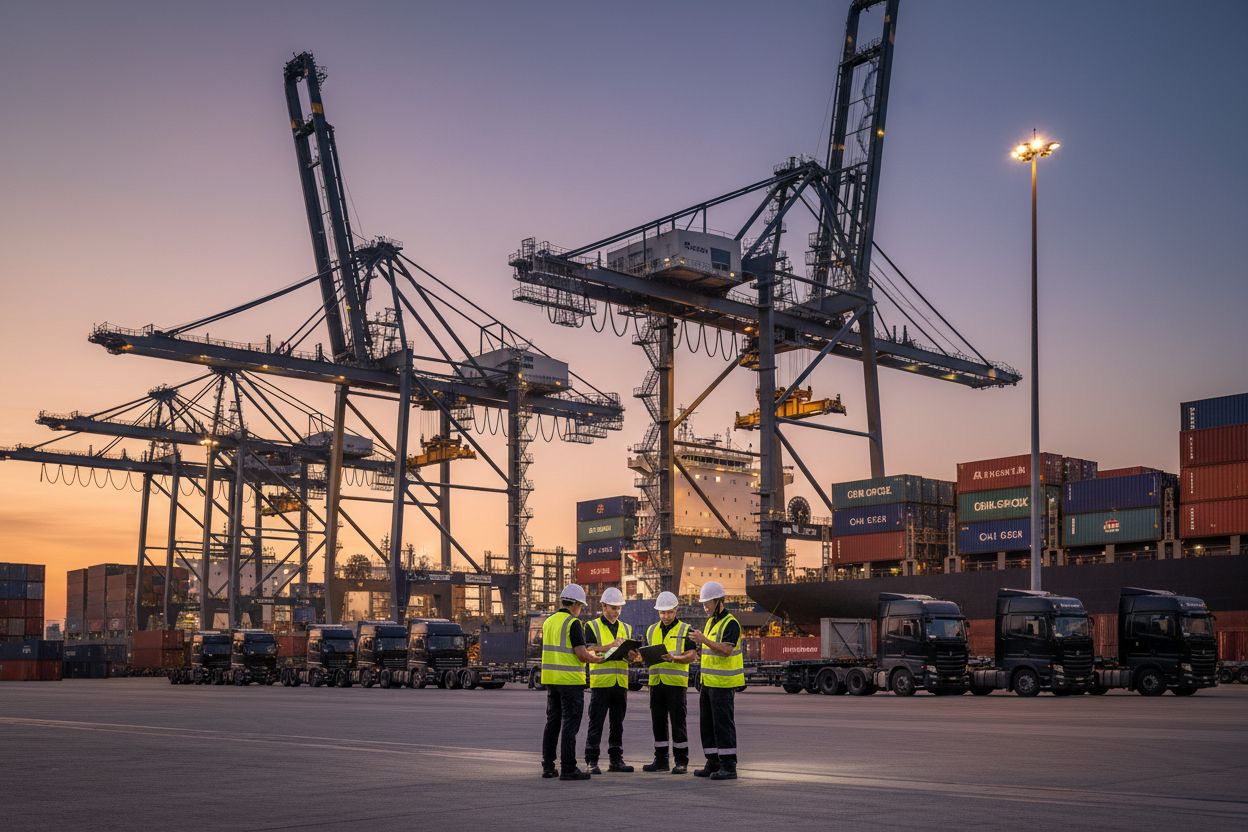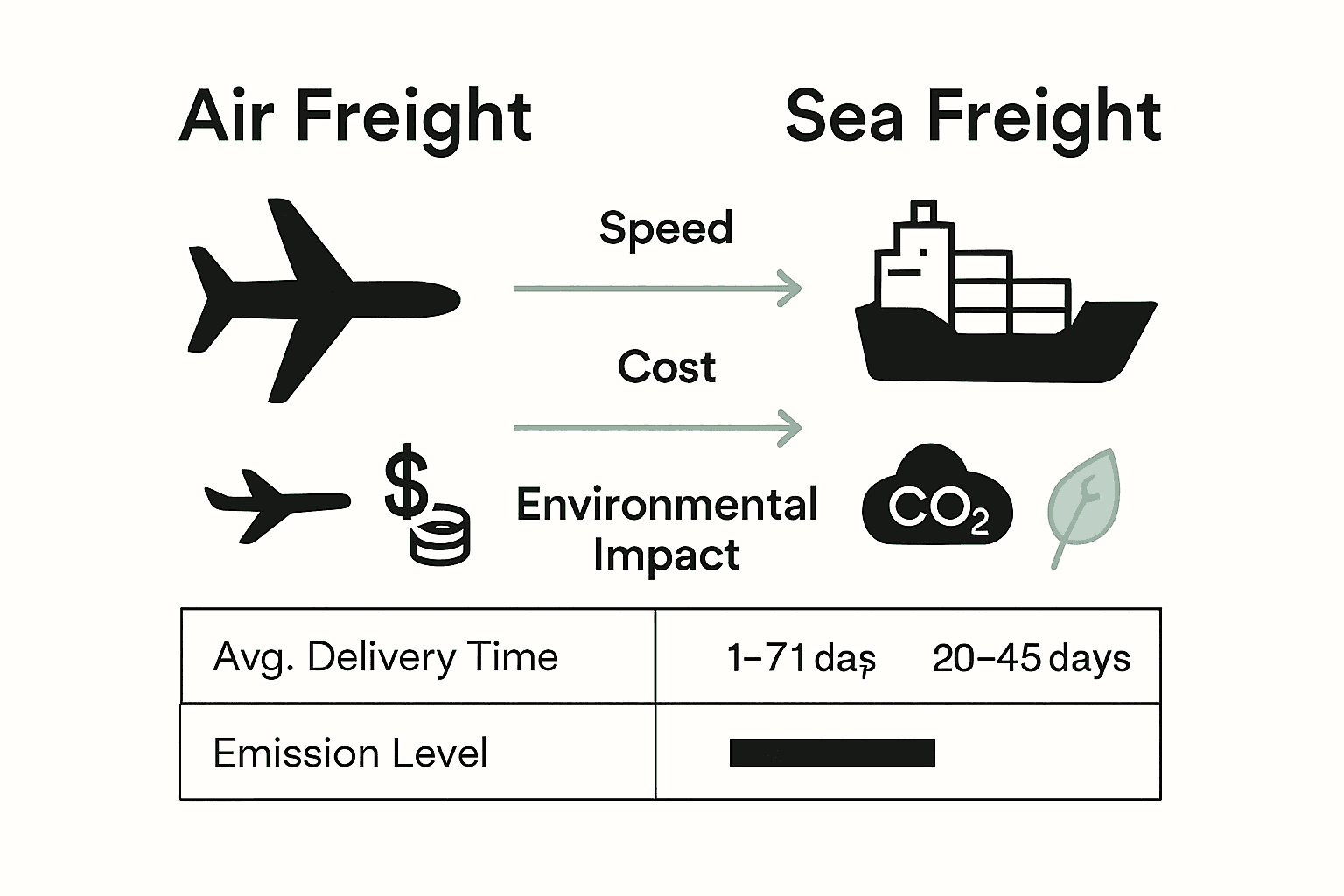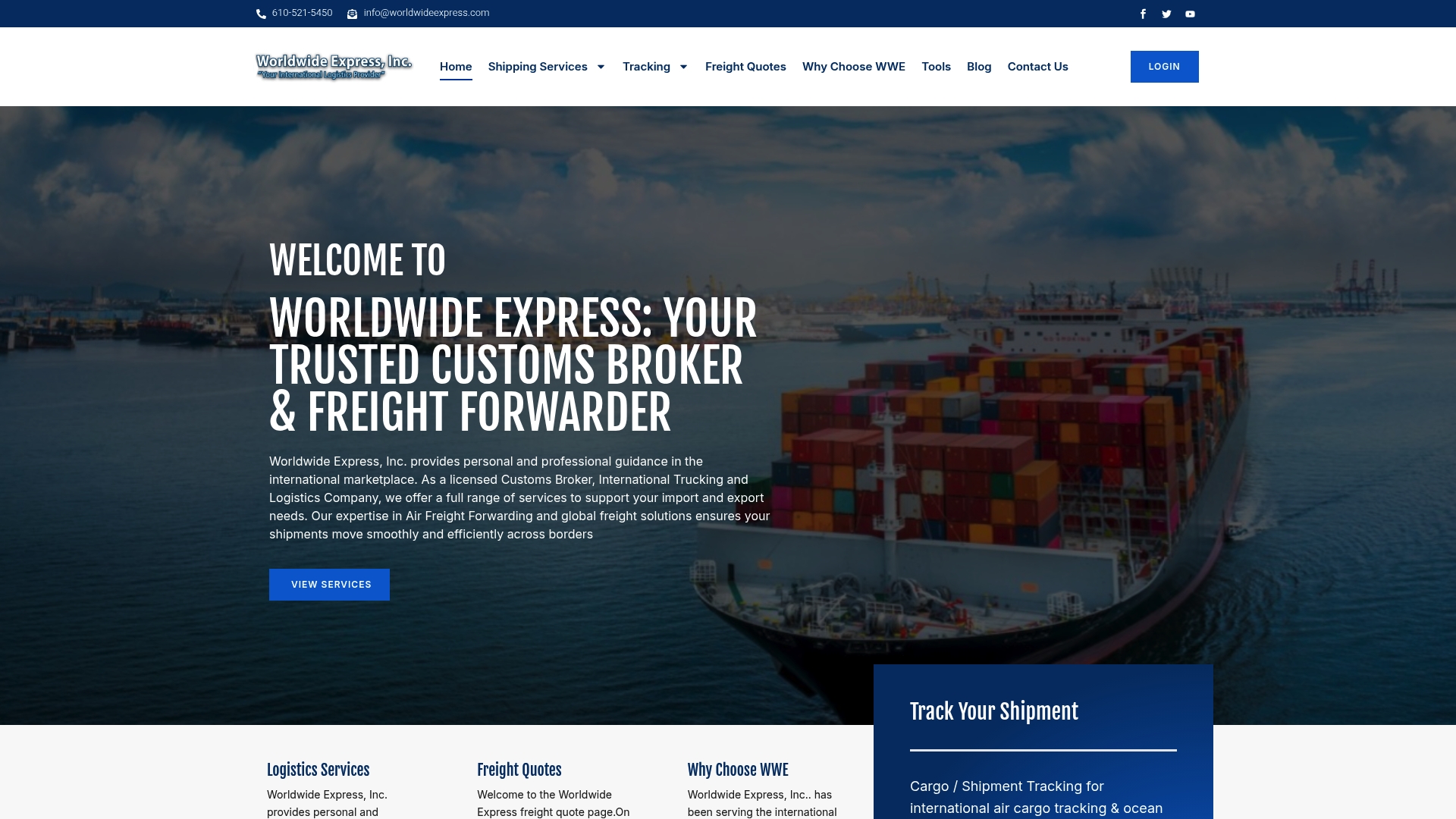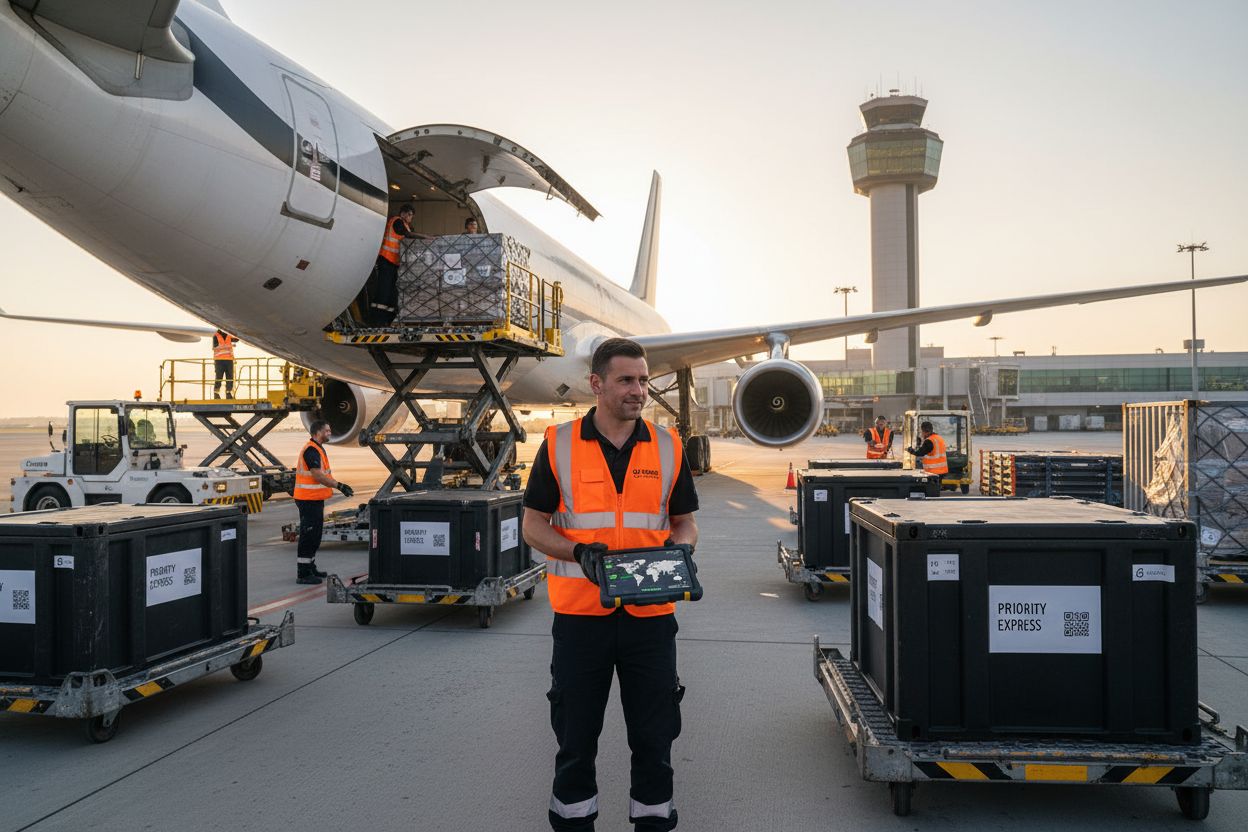Did you know that global freight shipments carry over 80 percent of world trade by volume? Whether your business needs to deliver goods quickly or move large shipments cost-effectively, understanding the differences between air freight and sea freight is crucial. The right choice can shape delivery times, pricing, and even your environmental footprint, giving you a real competitive edge in the international marketplace.
Key Takeaways
| Point | Details |
|---|---|
| Speed vs. Cost | Air freight is significantly faster than sea freight but comes at a higher cost. Businesses must balance urgency with budget constraints. |
| Documentation Differences | Air freight uses an Air Waybill, while sea freight relies on Bills of Lading and packing lists, influencing regulatory compliance and ownership transfer. |
| Cargo Suitability | Air freight is ideal for lightweight, urgent shipments, while sea freight is more economical for large, heavy cargo with flexible delivery timelines. |
| Emerging Technology Impact | Advancements in technology and sustainability trends are reshaping logistics strategies and influencing the choice of transportation methods in the coming years. |
Table of Contents
- Defining Air Freight And Sea Freight Methods
- Major Differences In Shipping Processes
- Speed, Cost, And Reliability Compared
- Regulatory Compliance And Documentation
- Choosing The Right Freight Mode For Your Business
Defining Air Freight and Sea Freight Methods
When it comes to international shipping, air freight and sea freight represent two fundamental transportation methods with unique characteristics that can dramatically impact your logistics strategy. According to global shipping resources, each method serves distinct business needs depending on cargo volume, urgency, and budget considerations.
Air freight operates through specialized cargo aircraft, making it the go-to choice for time-sensitive shipments weighing under approximately 1,000 kg. This method offers lightning-fast transit times, typically ranging from 2-10 days internationally, which makes it perfect for perishable goods, high-value items, or products with strict delivery windows. Read more about freight documentation to understand how air shipments are tracked and managed.
By contrast, sea freight leverages massive container ships to transport substantially larger cargo volumes across global maritime routes. This method excels in cost-effectiveness for heavyweight shipments, with transit times spanning 20-45 days depending on international routes. Sea freight becomes economically advantageous when dealing with:

- Bulk cargo weighing over 1,000 kg
- Large machinery or equipment
- Standardized shipping containers
- Goods with flexible delivery schedules
The primary differentiator between these methods lies in their documentation. According to Wikipedia, air freight utilizes an Air Waybill (AWB), which serves as a non-negotiable transport document and contract of carriage. Unlike sea freight documents, an AWB does not transfer ownership, providing a unique administrative framework for international air transportation.
Major Differences in Shipping Processes
The shipping processes for air and sea freight represent dramatically different logistical approaches, each with unique workflows that impact transportation efficiency. According to research from shipping logistics experts, these methods diverge significantly in handling, documentation, and operational complexity.
Air freight processing is characterized by its streamlined, centralized approach. Airports provide a more standardized environment with fewer touchpoints, which translates to faster documentation and cargo handling. This efficiency makes air shipping ideal for businesses requiring rapid, precise logistics. Explore our guide on reducing shipping costs to understand how these processing differences impact overall transportation expenses.
In contrast, sea freight processing involves a more intricate series of steps. According to international shipping sources, sea shipping follows a comprehensive process that includes:
- Issuance of commercial invoices
- Preparation of detailed bill of lading
- Creation of comprehensive packing lists
- Loading procedures at multiple seaports
- Navigating complex customs clearance protocols
- Extensive cargo handling across different maritime jurisdictions
The documentation complexity in sea freight reflects the method’s inherent challenges: multiple international checkpoints, varied regulatory environments, and longer transit times. Sea shipping relies heavily on Incoterms (International Commercial Terms) to standardize global trade processes, ensuring clear responsibilities and expectations across different shipping stages.
Here’s a comparison of major differences between air freight and sea freight shipping processes:
| Aspect | Air Freight | Sea Freight |
|---|---|---|
| Workflow Complexity | Streamlined Centralized |
Multi-stage Complex steps |
| Documentation | Air Waybill (AWB) | Bill of Lading Packing List |
| Main Processing Hubs | Airports | Seaports |
| Handling Touchpoints | Few | Multiple |
| Customs Procedures | Simpler Faster clearance |
Complex Lengthy clearance |
| Reliance on Incoterms | Limited | High |
Speed, Cost, and Reliability Compared
Selecting between air and sea freight involves carefully weighing three critical factors: speed, cost, and reliability. According to global shipping research, these transportation methods present dramatically different trade-offs that can significantly impact your logistics strategy.
Air freight emerges as the speed champion, offering remarkably quick transit times. Research from transportation experts reveals that shipping between the US and Asia takes just 1-3 days by air, compared to 18-25 days by sea. This rapid delivery comes at a premium—air shipping costs approximately 5-10 times more per kilogram than sea freight. However, the speed advantage makes air freight incredibly attractive for time-sensitive shipments. Learn strategies to manage shipping expenses to balance these cost considerations.
Reliability metrics further distinguish these shipping methods. Air freight boasts an impressive on-time performance of 85-92%, significantly outpacing sea freight’s 65-75% reliability rate. For businesses where predictable delivery matters most, air shipping provides a more consistent option.

Interestingly, environmental considerations add another layer to this comparison. Ecological impact varies dramatically between transportation modes:
- Air freight emits approximately 6,500-7,200 kg CO₂ per 10,000 km
- Sea freight produces only 120-150 kg CO₂ for the same distance
Ultimately, the choice between air and sea freight depends on your specific business needs—balancing speed, budget, reliability, and environmental considerations.
Regulatory Compliance and Documentation
Navigating the complex world of international shipping requires a deep understanding of documentation and regulatory compliance specific to each transportation method. Regulatory frameworks differ substantially between air and sea freight, with each mode presenting unique documentation requirements that impact global trade operations.
In air freight, the Air Waybill (AWB) serves as a multifunctional document. According to Wikipedia, the AWB functions simultaneously as a contract of carriage, receipt of goods, freight bill, insurance certificate, and customs document. Critically, it remains non-negotiable and cannot be used for title transfer, which distinguishes it from sea freight documentation. Learn more about international trade compliance to understand these nuanced regulatory distinctions.
Sea freight documentation presents a more complex landscape. Research from maritime documentation experts highlights two primary document types:
- Negotiable Bill of Lading: Allows ownership transfer and acts as a document of title
- Sea Waybill: Streamlines cargo release without transferring title
These different documentation approaches reflect the distinct regulatory environments of maritime and air transportation. Businesses must carefully select the appropriate documentation based on their specific shipping requirements, understanding the legal implications and compliance obligations associated with each document type.
Choosing the Right Freight Mode for Your Business
Selecting the optimal freight transportation method is a strategic decision that requires careful analysis of multiple variables. According to shipping logistics research, the choice between air and sea freight hinges on several critical factors that extend beyond simple cost considerations.
Shipment size and weight play a pivotal role in mode selection. For smaller shipments under approximately 150 kg, air freight can surprisingly be more economical, while larger volumes invariably favor sea freight’s cost-effectiveness. Beyond these basic metrics, businesses must evaluate additional nuanced factors such as product characteristics:
- Perishability of goods
- Monetary value
- Time sensitivity
- Fragility of cargo
Looking toward 2025, emerging technological trends are reshaping freight selection strategies. Explore freight rate negotiation techniques to understand how evolving technologies impact shipping decisions. Research indicates significant developments on the horizon, including enhanced visibility through IoT and AI integration, sustainability considerations favoring lower-carbon transportation methods, and infrastructure improvements that could dynamically alter reliability and cost profiles.
Ultimately, there’s no universal solution. Businesses must conduct a comprehensive analysis, weighing speed requirements against budget constraints, environmental impact, and the specific characteristics of their cargo to determine the most appropriate shipping method.
Make Confident Freight Choices with Worldwide Express
Struggling to decide between air or sea freight for your business in 2025? The detailed guide above highlights how complex this decision can be. You must balance speed, cost, reliability, and compliance issues, all while keeping your supply chain moving smoothly. Many businesses feel overwhelmed by documentation requirements like the Air Waybill or Bill of Lading, lengthy customs clearance, and the constant pressure to deliver on time.

Partner with the experts at Worldwide Express to transform uncertainty into confidence. Our team specializes in complete international shipping solutions, offering customs brokerage, global tracking, and tailored freight forwarding for both air and ocean cargo. Let us handle the regulations and logistics planning so you can focus on what matters—growing your business. Take the next step now and reach out for a personalized consultation or instant freight quote at Worldwide Express.
Frequently Asked Questions
What is the primary difference between air freight and sea freight?
Air freight is faster and ideal for time-sensitive shipments, typically offering transit times of 2-10 days, while sea freight is more cost-effective for larger cargo volumes, with transit times ranging from 20-45 days.
How does the documentation process differ between air freight and sea freight?
Air freight uses an Air Waybill (AWB), which serves multiple functions without allowing ownership transfer. In contrast, sea freight relies on documents such as the Bill of Lading, which can transfer ownership, adding complexity to the shipping process.
When should a business choose air freight over sea freight?
Businesses should opt for air freight when dealing with smaller, high-value, or time-sensitive shipments, especially those under approximately 1,000 kg. Sea freight is preferable for bulky, heavier shipments that are not time-critical.
What impact does the choice between air freight and sea freight have on environmental sustainability?
Air freight has a higher environmental impact, emitting significantly more CO₂ per distance traveled compared to sea freight, making sea freight a more sustainable option for larger shipments.
Recommended
- Understanding International Shipping Costs: Key Insights – Worldwide Express, Inc.
- The Importance of Ocean Transportation in Global Trade
- Understanding Cargo Freight Forwarders and Their Role – Worldwide Express, Inc.
- Understanding Freight Rate Negotiation: Key Concepts Explained – Worldwide Express, Inc.






